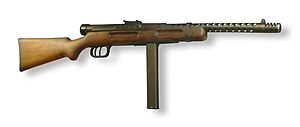Beretta M1938
| Beretta M1938 | |
|---|---|

|
|
| general information | |
| Civil name: | Beretta MPi |
| Country of operation: | Italy, Germany, Romania, Argentina, Japan |
| Developer / Manufacturer: | Tullio Marengoni, Beretta |
| Manufacturer country: | Italy |
| Production time: | 1938 to 1951 |
| Model variants: | M38, M38 / 42, M38 / 44, M38 / 49 |
| Weapon Category: | Submachine gun |
| Furnishing | |
| Overall length: | M1938: 950, otherwise 800 mm |
| Weight: (unloaded) | M1938: 4.2, otherwise 3.3 kg |
| Barrel length : | M1938: 315, otherwise 210 mm |
| Technical specifications | |
| Caliber : | 9 mm parabellum |
| Possible magazine fillings : | 10, 20, 30, 40 cartridges |
| Ammunition supply : | Bar magazine |
| Cadence : | 600 rounds / min |
| Fire types: | Single / continuous fire |
| Number of trains : | 6th |
| Twist : | right |
| Closure : | Mass closure |
| Charging principle: | Recoil loader |
| Lists on the subject | |
The Beretta M1938 , also known as the MAB 38 ( Moschetto Automatico Beretta ), was an Italian submachine gun that was used during World War II and the post-war period.
history
The MAB 38 was a successor to the MAB 18 , also designed by Tullio Marengoni for Beretta in 1918 , which in turn was based on the Villar-Perosa mechanism . The weapon was introduced to the Italian army and proved to be robust and reliable in use. Deliveries were also made to the German Wehrmacht , where they were listed as the 738 (i) and 739 (i) submachine guns . Production continued until long after the Second World War, with the last copies being used by the Italian military until the 1970s.
In the 1950s, the Federal Border Guard was also equipped with the weapon. Around 740 of these went to the Bundeswehr from 1955 onwards . The weapon was issued to troop leaders under the name MP1 and was replaced by the MP2 (UZI) from 1959 .
technology
In contrast to the original design, the stronger 9 mm Parabellum caliber was chosen and a muzzle brake was installed. The weapon itself was manufactured using very elaborate milling techniques, which made industrial mass production expensive and increased the weight of the weapon. In return, the Beretta was very robust and precise, and the compensator enabled a high hit density. A selector switch for the fire mode did not exist, but the characteristic double trigger. The front trigger triggered single fire, the rear continuous fire. If only the single fire trigger was used, the continuous fire trigger could be blocked by a safety switch. In the course of time, production was gradually switched to cheaper metal stamping technology, which is why several variants were created.
variants
- M1938 : perforated cooling jacket, bayonet holder, adjustable sighting device , muzzle brake with two large slots parallel to the barrel
- M1938 A : like M1938, but without bayonet holder and with modified muzzle brake with four small slots across the barrel
- M1938 / 42 : Variant to simplify production. The cooling jacket was removed, the barrel and the wooden components shortened, the adjustable sighting device replaced with a simple one and the muzzle brake was given two instead of four slots across the barrel
- M1938 / 43 : like 38/42, but with a simplified barrel
- M1938 / 44 : modified return spring mechanism, similar to the Sten Gun
- M1938 / 49 : Post-war model, also available with folding or telescopic shaft; alternative designations model 4 and model 5
literature
- Michael Heidler: Submachine guns 1939–1945: Development - Types - Technology . Motorbuch Verlag, Stuttgart 2019, ISBN 978-3-613-04186-8 .
- Ian Hogg : Military Small Arms of the 20th Century . Arms & Armor Press, 1982, ISBN 0-910676-87-9 .
- Infantry weapons yesterday . Brandenburgisches Verlagshaus, 1991, ISBN 3-327-01209-1 .
